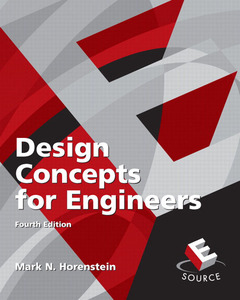Description
Design concepts for engineers
Author: HORENSTEIN Mark N.
Language: English
Approximative price 38.33 €
Subject to availability at the publisher.
Add to cart312 p. · 20.3x25.4 cm · Paperback
Contents
/li>
Contents
1 WHAT IS ENGINEERING? 1
1.1 Engineering Has Many Fields 2
1.1.1 Aeronautical Engineering 3
1.1.2 Agricultural Engineering 4
1.1.3 Biomedical Engineering 4
1.1.4 Chemical Engineering 5
1.1.5 Civil Engineering 5
1.1.6 Computer Engineering 7
1.1.7 Electrical Engineering 8
1.1.8 Environmental Engineering 8
1.1.9 Industrial Engineering 9
1.1.10 Materials Engineering 9
1.1.11 Mechanical Engineering 10
1.1.12 Mechatronics Engineering 10
1.1.13 Naval Engineering 11
1.1.14 Nuclear Engineering 11
1.1.15 Petroleum Engineering 12
1.1.16 Systems Engineering 12
1.2 Some Engineering Professional Organizations 13
1.2.1 American Institute of Aeronautics and Astronautics ( 13
1.2.2 Biomedical Engineering Society ( 14
1.2.3 American Institute of Chemical Engineers ( 14
1.2.4 American Society of Civil Engineers ( 14
1.2.5 Association for Computing Machinery ( 15
1.2.6 Institute of Electrical and Electronic Engineers ( 15
1.2.7 IEEE Computer Engineering Society ( 16
1.2.8 Institute of Industrial Engineers ( 17
1.2.9 American Society of Mechanical Engineers ( 17
1.2.10 Society of Petroleum Engineers ( 18
1.2.11 American Society of Agricultural and Biological Engineers
( 18
1.2.12 American Society of Naval Engineers ( 18
1.3 The Engineer: Central to Project Management 19
1.4 Engineering: A Set of Skills 23
1.4.1 Knowledge 23
1.4.2 Experience 24
1.4.3 Intuition 25
Key Terms 26
2 WHAT IS DESIGN? 27
2.1 The Use of the Word 'Design' 27
2.2 The Difference between Analysis, Design, and Replication 28
2.3 Good Design Versus Bad Design 36
2.4 The Design Cycle 39
2.4.1 Define the Overall Objectives 40
2.4.2 Gather Information 40
2.4.3 Identify and Evaluate Possible Design Strategies 41
2.4.4 Make a First Cut at the Design 41
2.4.5 Model and Analyze 42
2.4.6 Build, Document, and Test 42
2.4.7 Revise and Revise Again 44
2.4.8 Test the Product Thoroughly 44
2.5 Generating Ideas 47
2.5.1 Ground Rules for Brainstorming 48
2.5.2 Formal Brainstorming Method 48
2.5.3 Informal Brainstorming 53
2.6 Design Examples 58
2.6.1 Model Vehicle Design Competition 58
2.6.2 DVD Production Facility 66
2.6.3 Automatic Pipette Machine 71
Summary 82
Key Terms 82
Problems 82
3 PROJECT MANAGEMENT AND TEAMWORK SKILLS 91
3.1 Working in Teams 91
3.1.1 Building an Effective Team 92
3.1.2 Organizational Chart 94
3.1.3 The Job Description 95
3.1.4 Team Contact List 96
3.1.5 Team Meetings 96
3.1.6 Working with Other Teams in the Organization 96
3.2 Managing Tasks: Keeping the Project on Track 99
3.2.1 Checklist 99
3.2.2 Timeline 100
3.2.3 Gantt Chart 100
3.2.4 PERT Chart 101
3.3 Documentation: The Key to Project Success 106
3.3.1 Paper versus Electronic Documentation 106
3.3.2 The Engineer's Logbook (Notebook) 107
3.3.3 Logbook Format 108
3.3.4 Using Your Engineer's Logbook 109
3.3.5 Technical Reports and Memoranda 111
3.3.6 Software Documentation and the Role of the Engineering Notebook 111
3.3.7 The Importance of Logbooks: a Case Study 113
3.4 Legal Issues: Intellectual Property, Patents, and Trade Secrets 116
3.4.1 Patents 116
3.4.2 Patent Jargon 117
Key Terms 117
Problems 117
These books may interest you

Design Concepts for Engineers 94.54 €



